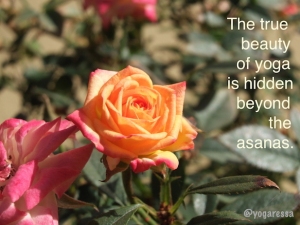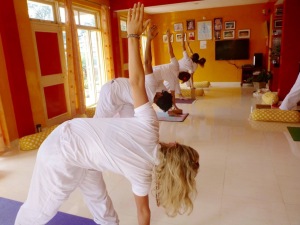Poop, Pray, Move [Part 3] – with apologies to Elizabeth Gilbert
MOVE …
I’ve been condensing two months of extensive yoga studies in India into 5 key areas, to simplify maintaining this healthy lifestyle, back home. Part 1 and Part 2 covered the Poop and Pray part, and now we add Move.
Surprise, surprise … in India, yoga is not typically an exercise you come to perform on your mat three times a week – it’s a way of life; more than just a workout.
Asanas (the physical yoga postures) are not yoga. They are a part of yoga. Here’s a perfect analogy, from our teacher, Yogi Sivadas: “It’s like touching a thorn on a rosebud and thinking that is all that a rose is – you’ll say ‘rose is prickly’ and you’ll miss out on smelling the perfume, because the flower hasn’t blossomed yet. If you only do asana, you won’t find the hidden beauty of yoga, which is inner peace.” The true beauty of yoga is hidden beyond the asanas. The asanas are a way of purifying the body and when the flower unfolds, we experience the hidden beauty within. A sort of yoga perspective on “Stop and smell the roses”.


Every day.
Twice a day.
Four hours a day.
Here’s the difference. We didn’t approach our asanas with the kind of fervid and fanatical drive that we so often see in yoga. Yogi Sivadas’ constant message was, “slow down, take your time, feel your breath, always be mindful about what your body needs, rest when you need to”. We listened, and ironically, our bodies became stronger and more flexible through a path of ease and mindfulness, as opposed to a grim determination to muscle our way through countless vinyasas and pretzel poses.
“Yoga pose is a steady and comfortable position. Yoga pose is mastered by relaxation of effort, lessening the tendency for restless breathing, and promoting an identification of oneself as living within the infinite breath of life.” – The Yoga Sutra of Patanjali
Patanjali reminds us that calm and measured breathing is a critical part of healthy yoga movement, even when we are doing challenging poses. In fact, especially when we are doing challenging poses. That’s the barometer for whether we are overdoing it. Throughout our yoga asanas, we keep connecting again and again to the breath; breathing fully and allowing a smooth and even breath to feed the body and calm the mind.
We also learnt it’s not necessary to hold a pose at its maximum, for as long as possible. I’m not a physiotherapist nor a physiology nerd, but if the muscles fatigue to the point where they’re no longer doing a good job of holding the pose, we can end up stressing the joints (NOT good!) And if we then lock the joints to maintain a pose on behalf of fatigued muscles, we’re not engaging and strengthening the muscles – instead we can end up compressing the joints (NOT good!) Finally, when we’re straining and forcing the pose, the muscles become tighter, instead of stretched. The tighter they become, and the more we push into the stretch? Perfect combination for injuries to happen (yes, here it comes again … NOT good!)


I love my asana practice. It makes me feel alive, it calms my mind, it connects me to my breath. After my time in India, my asana practice is both strong AND therapeutic, a place of even more ease. I’m being kinder to my joints, I’m aware of my heartbeat and breathing, and any time I feel the need to do MORE, I pause and ask myself if what I am already doing is enough, and can I still feel the relaxation in the effort?
And when the answer is yes, I know am in that perfect place to experience the unfolding of the rose flower and inhale the heady scent of yoga.
Next up: Part 4 of Poop, Pray, Move … what else do you think is fundamental to a healthy yoga lifestyle?




Julie, I read and reread every word you write. All this is not easy but I am trying to calm my mind because I know this is important and it will impact my life. Are the Yoga people is India more calm? Most of the friends I know are not calm including me. Thank you so much for all you bring to every yoga class. Berkeley
Thank you for reading, Berkeley – your interest makes me want to keep writing and sharing the things I’ve learned from others. This Yoga Thing is an ongoing process, one that will keep me busy for a lifetime. You’re right that it’s not always easy, but it is worth the effort. It’s okay if you don’t feel calm all day, every day. Calming the mind takes regular practice. Within minutes or hours, you may feel agitated again, but keep a daily commitment to meditation or quiet time and you may start to notice small changes in the way you feel, even on days that are challenging.
Meditation and yoga help us build awareness. Awareness of body, mind and spirit. We start to notice how the choices we make impact our lives – the way we think, speak and act – and we choose to do more of the things that create an inner quiet. Just like in Savasana, there can be chaos around you, and calm within.
Keep doing the yoga, keep meditating, keep breathing and keep happy!
Namasté.
Hi Julie, I really enjoyed the hypermotiliy/knee reference. My ligaments in general tend to be that. I will be mindful of the alterations I can make in my practice to safeguard my ‘maturing’ joints.
Thank you,
Gerry
Hi Gerry, that inspires me to keep writing! I’ve been remiss, and busy with a yoga retreat to Guatemala (fabulous, it was), and so have neglected my blog, but have been gnashing my teeth, wanting to get back to it as soon as possible – thank you for the encouragement.
Re the hyperextension in the knees – SO important, whether maturing joints or young ‘uns, and this I know from experience. Just Google “overstretched tendon behind knee” and see how many other people are suffering from the same thing. The problem is, once you realize you’ve overstretched (knees or elbows), the damage is often done, and, it seems, difficult to repair. Remember the alignment cues, in poses like Downward Facing Dog, where the legs are straight and engaged – “Strong legs, soft knees joints; strong arms, soft elbows”. Here’s to your happy yoga for the summer and see you soon!
[…] and without balance, we can find ourselves depleted. Balanced diet, balanced sleep, balanced exercise, balance in how much we work and how much we rest and play, balance in our personal […]